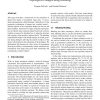Free Online Productivity Tools
i2Speak
i2Symbol
i2OCR
iTex2Img
iWeb2Print
iWeb2Shot
i2Type
iPdf2Split
iPdf2Merge
i2Bopomofo
i2Arabic
i2Style
i2Image
i2PDF
iLatex2Rtf
Sci2ools
116
click to vote
PAMI
1998
1998
Shape Evolution With Structural and Topological Changes Using Blending
This paper describes a framework for the estimation of shape from sparse or incomplete range data. It uses a shape representation called blending, which allows for the geometric combination of shapes into a unified model— selected regions of the component shapes are cut-out and glued together. Estimation of shape using this representation is realized using a physics-based framework, and also includes a process for deciding how to adapt the structure and topology of the model to improve the fit. The blending representation helps avoid abrupt changes in model geometry during fitting by allowing the smooth evolution of the shape, which improves the robustness of the technique. We demonstrate this framework with a series of experiments showing its ability to automatically extract structured representations from range data given both structurally and topologically complex objects.
Related Content
| Added | 23 Dec 2010 |
| Updated | 23 Dec 2010 |
| Type | Journal |
| Year | 1998 |
| Where | PAMI |
| Authors | Douglas DeCarlo, Dimitris N. Metaxas |
Comments (0)

